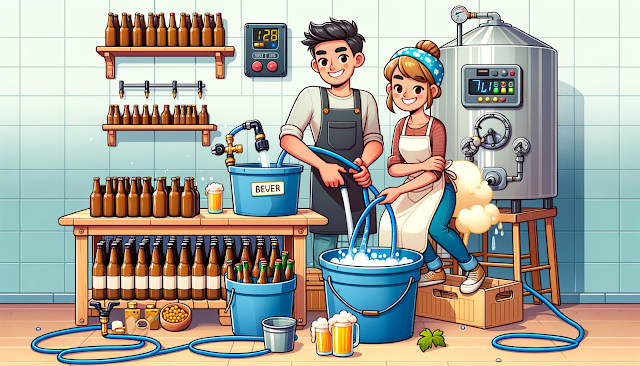For those who aren’t ready to make the leap to kegging, due to either scale or expense, optimizing the bottling process is essential. Let’s explore five methods to streamline this process and get your beer bottled more efficiently.
1. Mass Sanitization in a Large Container
Sanitizing is non-negotiable in brewing. To sanitize a large batch of bottles at once, use a sizable container, like a plastic washing basket. Fill it with water, add a cleaner like sodium percarbonate, which is no-rinse, and immerse your bottles. This method not only saves time but also ensures that each bottle is sanitized. For a 23-liter batch, a 30 or 35-liter bucket will suffice to accommodate all the bottles you’ll need.2. Batch Priming
Batch priming is a method where you mix the total amount of priming sugar with the entire batch before bottling, rather than adding sugar to each individual bottle. This technique not only saves time but also minimizes the mess typically associated with sugar handling during bottling. It's a straightforward process that requires some calculations to determine the right amount of sugar needed, taking into account the type of beer and desired carbonation level.3. Sugar Measurement for Priming
The quantity of sugar needed varies with the type of beer. Lager beers generally require more sugar to achieve higher carbonation compared to ales. Here are some commonly used measurements for a 23-liter batch:- Dextrose (Corn sugar): 3/4 cup or 4 or 5 oz / 95 grams
- Cane sugar: 2/3 cup or 3.8 - 4.8 oz / 86 grams
- Dry Malt Extract: 130 grams
For different volumes, it’s advisable to use a priming calculator to get the precise measurement.
4. Utilizing a Bottling Wand
A bottling wand simplifies the filling process. Attached to your tap, it allows for a controlled flow of beer into the bottle, minimizing oxygen exposure. The wand’s valve opens when the wand is pressed against the bottom of the bottle and closes when lifted, preventing spills and the need to constantly open and close the tap.5. Choosing the Right Capping Tool
When it comes to capping, you have two main tools: the handheld capper and the bench capper. The handheld capper, like the universal Rigamonti or the Red Baron, is portable and easy to use. However, applying too much force can cause the bottle to break or make it difficult to remove the capper.The bench capper, on the other hand, offers a more stable capping process with a simple lever action, and it’s advisable to choose one that accommodates various bottle sizes.
Post-Bottling: Beer Conditioning
Once bottled, beer needs to condition. The conditioning environment should have a consistent temperature, with ales preferring cooler conditions and lagers tolerating slightly warmer ones. The location within your home matters, with central areas typically being cooler. Avoid direct sunlight and excessive heat, and after at least three weeks of rest, chill your beer before enjoying it.
By implementing these methods, you can greatly reduce the time and effort involved in the bottling phase of brewing. Not only does this make the process more enjoyable, but it also allows for greater focus on the quality and flavor of the beer, which is, after all, the ultimate goal of homebrewing.


